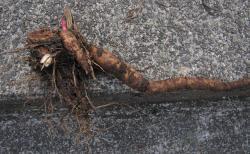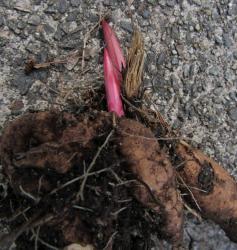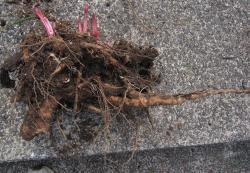Yes, I know the recommendation is against spring transplant. But it is so much easier in the spring to figure out what you're doing in a transplant.
I moved half of a very old cluster of Peony to a slightly sunnier location, and from a level bed right next to a giant pine tree to a raised bed next to a different giant pine tree.
Since I never dug up a Peony before, I had little clue what to expect. I broke off more than I took of the half I moved and I think I broke off even more of the half I didn't take.
I was surprised at how big the tubers and tuberous roots are, and more surprised at how fragile it all is, with the single annoying exception of last year's stems. Those stems are super strong and super attached to the main underground structure of the plant ("crown", or "tuber" or whatever). I'm used to other perenials where I just break off last year's stems by hand, rather than having clippers with me. I did quite a bit of harm trying that, before going back for clippers.
As much as I could, I avoided even touching the red shoots. Some broke off anyway.
I was surprised that half the tuberous roots go down just a few inches before turning horizontal and going off to the far distance (but over many years there, never sending up new shoots in the distant spots reached by those roots). It looks like the ones that stayed vertical went similarly far down. But all the vertical ones broke (with almost no force) when I disturbed the plant. Almost all the horizontal ones similarly broke. All that happened to the half I was trying to lift, but also to the half I wasn't trying to lift.
I was also surprised and unhappy at how few ordinary roots came with the tubers. I think they are so fragile the weight of the dirt ripped them off (as it became looser and freer to move), even though I was careful to lift from below that dirt.
Other than the red shoots, I'm not convinced everything being so fragile is a result of wrong time of year. Please correct me if I'm wrong about that. Are the tuberous roots tougher at other times of year?
I did not intentionally separate anything. The break into 5 sections (3 of which are in the photos below) happened in the first exploratory lift of dirt deep under the half I wanted to take.

Next is a closeup of the above:


Next is a closeup of the above:

The right end of this next one certainly looked like a new shoot developing from the narrow (far) end of a horizontal tuberous root. It happened that horizontal root started from the north edge of the cluster and pointed back across to the east edge of the cluster. No shoots ever came up outside the cluster, which has been the same place and size for over 30 years. So do those horizontals normally extend the cluster and something else is wrong with the original location? Or was I misunderstanding the appearance that this shoot is from the far end of a horizontal?





